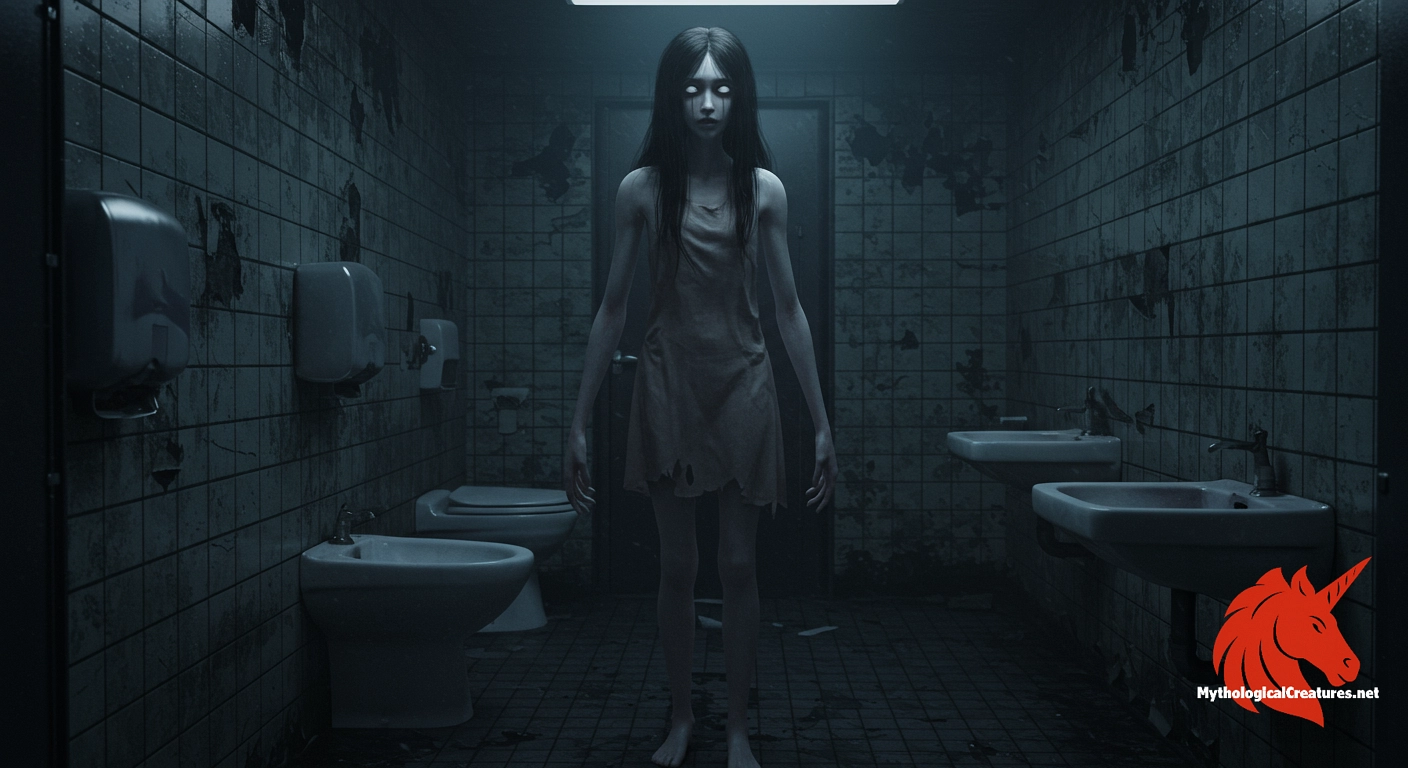Hanako-san: Hanako-san is a ghostly urban legend from Japan, known to haunt school bathrooms and capture the imaginations of students through eerie tales and mysterious appearances.

Hanako-san
Hanako-san - Serves as a cautionary tale and a ubiquitous figure in Japanese school ghost stories, embodying themes of tragedy and mystery.
Origins & First Encounters
Hanako-san, widely known as 'Toire no Hanako-san', is an enigmatic figure in Japanese urban folklore whose ghostly presence is said to haunt school restrooms. Her legend has grown from whispered childhood rumours into a cultural phenomenon that bridges modern anxieties and traditional ghost lore. Multiple origin stories coexist, with some suggesting she was a wartime victim, others proposing she fell prey to violence, and still more recounting a tragic suicide in a school toilet due to relentless bullying. Each narrative variant reinforces the notion that her story is as mutable as it is mysterious, reflecting the shifting concerns of society. The earliest attestations of her tale appear in postwar Japan, where rapid social change and the scars of historical conflicts provided fertile ground for supernatural legends. Over time, her image has been interwoven with local and national narratives, symbolising both youthful innocence lost and the underlying tensions of modern urban life. In many retellings, the spectre of Hanako-san serves as a poignant reminder of unresolved grief and the ephemeral nature of recollection. Her enduring presence in popular discourse attests to the way folklore adapts to contemporary contexts. This myth continues to inspire both caution and curiosity, inviting each new generation to engage with the mystery that she embodies.
Source Texts & Tale Variants
The primary narratives surrounding Hanako-san are preserved largely through oral tradition, passed down in hushed tones in school corridors and playgrounds. Local anecdotes, though undocumented in formal literature, have been gathered over decades and compiled into various folklore collections. Some modern ghost story anthologies include her tale alongside those of other yūrei, contributing to her status within Japanese supernatural lore. Distinct variants exist, with some accounts claiming she perished during air raids and others detailing her as a victim of violent crime or unbearable bullying. These diverse stories not only mirror regional differences but also echo the evolving cultural anxieties of different time periods. In recent decades, her legend has transcended oral narration and made its mark in manga, anime, films, and even video games. Online platforms have further enriched her narrative, allowing new interpretations and retellings to emerge. Folklorists have noted that this continual evolution and adaptation capture the dynamic nature of urban legends. In essence, Hanako-san’s lore stands as a layered narrative, woven from collective memories and ever-changing social concerns.
Form & Powers
Physical depictions of Hanako-san vary widely, yet several enduring features consistently lend her an unmistakably spectral quality. She is most often envisioned as a young girl with a pallid, almost translucent complexion that underscores her otherworldly presence. Her long, unkempt hair and deep, enigmatic eyes are frequently noted, the latter often conveying a mixture of sorrow and mystery. In many portrayals, she is depicted wearing either a simple school uniform or traditional Japanese attire, each detail echoing her connection to the spaces where her legend thrives. Her slight, almost insubstantial form reinforces the idea that she is more a fleeting apparition than a corporeal entity. Artistic interpretations sometimes include a subtle glow around her figure, a visual cue to the ethereal light of lost time and lingering regret. The occasional inclusion of a faint, wistful smile or the suggestion of movement in her garments deepens the impact of her mysterious appearance. Modern renderings occasionally introduce elements that hint at the wear and decay of time, aligning her visage with the tragedy of her untimely demise. Overall, the physical portrayal of Hanako-san strikes a compelling balance between delicate beauty and the haunting shadow of sorrow.
Regional Faces
Regional variations of the Hanako-san legend highlight the rich tapestry of local beliefs and historical influences across Japan. In bustling urban centres, her narrative is predominantly associated with the modern school restroom—a setting that heightens the thrill and apprehension of her ghostly appearance. In more rural communities, however, her story often intertwines with local kami or ancestral spirits, creating a blend of traditional animistic beliefs with modern urban myth. Some regions portray her as a benign presence that subtly protects the premises she haunts, while others emphasize her role as a vengeful spectre whose appearance is an omen of misfortune. Local customs and summoning rituals also vary, with distinct regional practices adding unique layers to her overall mythology. Particular landmarks, such as an aged school building or a secluded lavatory with a peculiar red door, often become central to area-specific versions of her tale. These regional adaptations reflect local histories, cultural sensibilities, and the collective memory of personal and communal tragedies. As modern education and social dynamics evolve, so too does the way communities interpret and retell the Hanako-san legend. Thus, her story remains multifaceted, continually reshaped by the intersection of national folklore and regional identity.
Cultural Parallels
Comparative analysis reveals that Hanako-san shares intriguing thematic parallels with ghostly figures from diverse cultural traditions. Her narrative, centred on the untimely death of a young girl and her subsequent spectral existence, echoes the broader yūrei traditions of Japan, where spirits remain bound by unresolved earthly passions. Similar motifs appear in Western ghost legends such as La Llorona, where the haunting of a tragic female figure captures universal concerns of loss and retribution. The delicate interplay of innocence and sorrow present in her story is a recurrent theme in supernatural folklore worldwide. In East Asia, comparable legends in Korea and China also involve youthful apparitions whose tragic fates spur lingering hauntings. The modern reinterpretation of her tale—sometimes even incorporating a male counterpart like Hanako-kun—further illustrates her flexible role in contemporary urban myth. Such fluidity mirrors trends seen in other modern legends, where traditional ghostly characteristics adapt to reflect current societal issues. The evolution of her story underscores a common cultural dialogue about childhood vulnerability and the spectre of unresolved grief. In this way, Hanako-san not only epitomises uniquely Japanese folklore but also resonates with global narratives of supernatural loss and the persistence of memory.
Legacy & Modern Evolution
The historical evolution of Hanako-san’s legend is a striking example of how folklore adapts to the rhythms of changing times. What began as a whispered tale among schoolchildren has steadily grown into a cultural icon, reflecting both historical traumas and modern societal anxieties. Over the decades, her story has migrated from the realm of oral tradition to become a fixture in contemporary media across manga, anime, films, and video games. This transition has introduced fresh perspectives, including gender-reversed versions like Hanako-kun, which demonstrate the fluidity and resilience of her mythos. Modern reinterpretations often explore deeper themes such as social isolation, the scars of bullying, and the broader implications of a rapidly changing society. As a result, her character has gathered layers of meaning that resonate with multiple generations and cultural trends. Her enduring presence in urban discourse serves not only as a playful challenge among schoolchildren but also as a metaphor for lingering historical and emotional spectres. Innovative adaptations continue to reframe her narrative, ensuring that her ghostly visage remains both timeless and contemporarily relevant. Ultimately, Hanako-san’s legacy endures as a dynamic testament to the enduring power of myth, continually reimagined to reflect the fears and hopes of each era.
Interesting Fact
An intriguing aspect of Hanako-san is the fluidity of her legend—varying origin stories and the emergence of a male variant (Hanako-kun) highlight how urban myths evolve and mirror cultural shifts over time.
Quick Creature Info
Associations:
Our Mythic Legendary Rating:

Also Sometimes Known As:
Habitat:
Supernatural Powers:
Physical Attributes:
Abilities:
Behavior:
Lore:
Related Creatures, Tales or Lore
- KKuchisake-onna
- TTeke Teke
- OOkiku
References
Discover Another Mythical Legend You May Not Have Heard Of?
Uncover the mysteries of ancient folklore and expand your knowledge of legendary beings from cultures around the world.
Dare to Meet the Amabie....
Curated by the Mythological Creatures Team (rev. May 2025)
